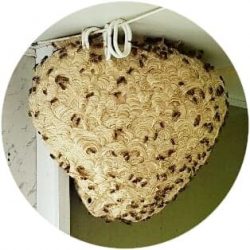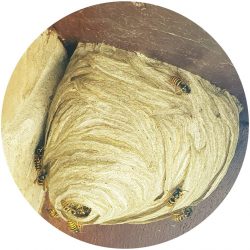WASP CHARACTERISTICS These belong to the order of insects know as Hymenoptera and similar to the ant species will operate a Caste system of nests which nurse and feed the young wasps, carry out a feeding programme to the nest, all revolving around a single Queen. Wasps possess a narrow waist which give the body (abdomen) great mobility, it has a sting on its Ovipositor, distinctive yellow and black markings and powerful jaw parts.
Typically, the life cycle will see The Queen emerge from hibernation and construct a small nest. The nest construction is a true work of art. Made up of wood splinters, which are thoroughly chewed to make a pulp mixture and then expertly spread to make a papery construction. The paper is then moulded into six-sided cells and arranged in horizontal layers. The Queen lays one egg in each cell and this hatches in 3 – 5 days. The first adults emerge between 16-35 days and carry on construction of the nest and feeding and nursing the larvae. The Queen continues to lay eggs and the nest size can reach tens of thousands. The nest will thrive into early winter when the young Queens are produced. These will then hibernate in suitable locations (e.g. attics) until next year when the process starts all over again. All workers and males will die resulting in the cessation of the nest.
MAIN SPECIES OF WASPS IN THE UK ARE:
a) Vespula vulgaris (Common Wasp)
b) Vespula germanica (German Wasp)
For further details and information on treatments of these pest species, please contact P & P PEST CONTROL LTD on 01873 830204 or email us for free advice and/or a no obligation survey.



